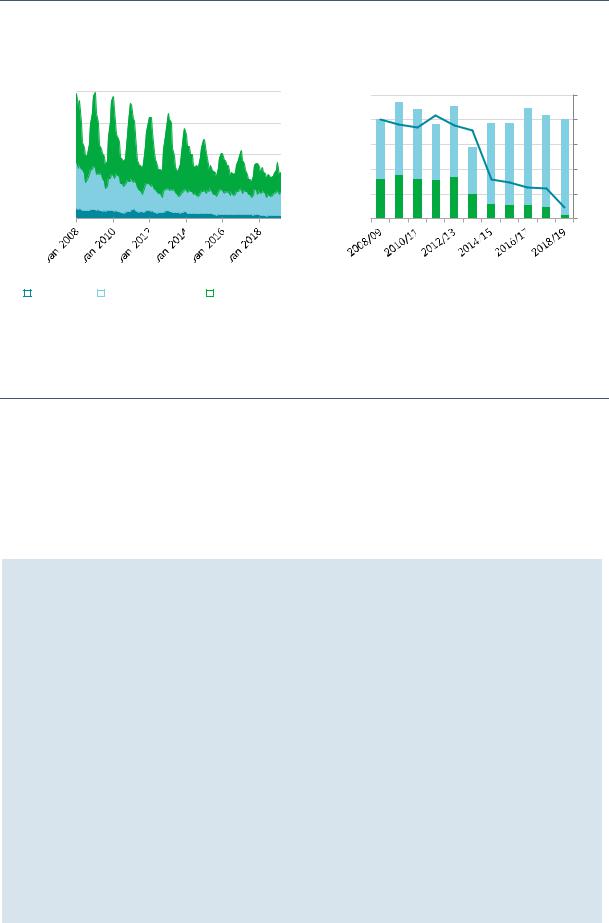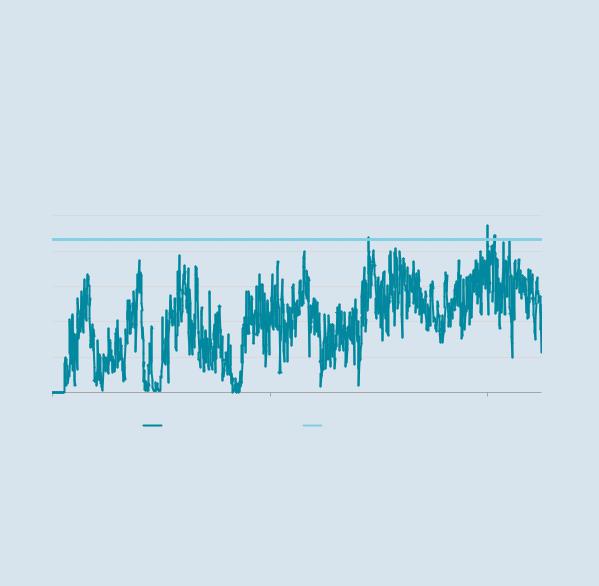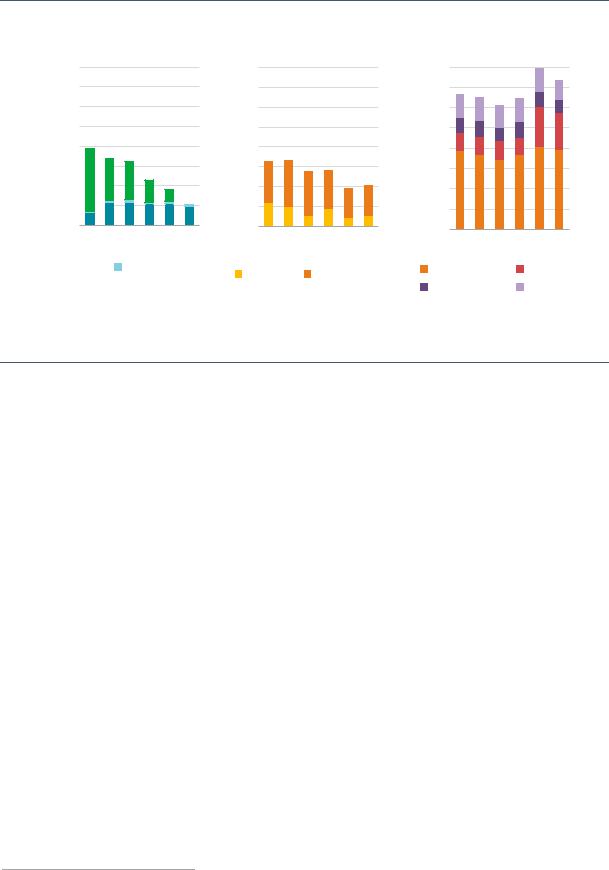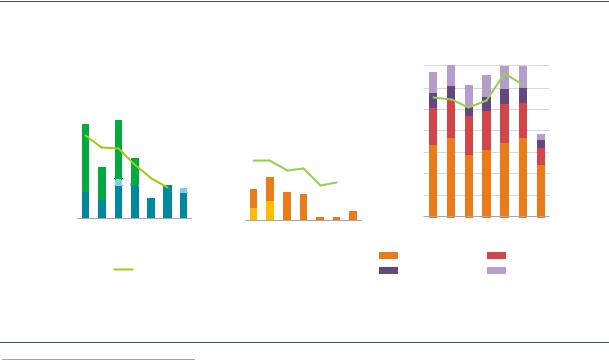
- •Abstract
- •Foreword
- •Executive summary
- •The drive for flexibility
- •Driven by portfolio players, LNG contracting activity rebounded to its highest level in five years…
- •… underpinned by longer, larger and more flexible contracts
- •Innovation in LNG contracting to enhance regional security of supply…
- •…means traditional buyers could become a larger source of additional flexibility for the Asian LNG market
- •The transformation of the broader energy system in north-western Europe…
- •…calls for the further enhancement of downstream gas flexibility
- •Findings and recommendations
- •Key findings
- •Update on LNG market flexibility metrics
- •LNG supply security in Asia: An opportunity for traditional buyers
- •North-western Europe’s gas flex: Still fit for purpose?
- •Technical analysis
- •1. Update on LNG market flexibility metrics
- •Introduction
- •Update on LNG contract trends
- •Liquefaction activity: New wave of investment gaining momentum
- •Export source and import destination: Flexible gas gaining ground
- •Longer and larger contracts do not mean less flexibility
- •Portfolio players and flexibility
- •Analysis of contract flexibility
- •Pricing trends
- •References
- •2. LNG supply security in Asia: An opportunity for traditional buyers?
- •Introduction
- •LNG flexibility in Asia
- •Flexibility in long-term contracts
- •Options in LNG contracts
- •Valuation of options
- •Flexibility in Japanese LNG contracting
- •Innovation in contracting
- •Expansion of LNG network
- •Creating joint ventures
- •Expanding LNG outlets
- •Proximity and security of supply
- •References
- •3. North-western Europe’s gas flex: Still fit for purpose?
- •Introduction
- •Gas flexibility toolkit
- •North-western Europe’s gas demand: Seasonality and volatility
- •Current state of flexibility tools
- •Upstream deliverability
- •Import capacity
- •Midstream interconnectivity
- •Storage capacity
- •A transforming energy system
- •References
- •General annex
- •Abbreviations and acronyms
- •Acknowledgements
- •Table of contents
- •List of figures
- •List of boxes
- •List of tables

Global Gas Security Review 2019 |
General annex |
Gas demand from the industrial sector has a relatively flat profile when compared with the seasonality of the residential and commercial sectors or the volatility of gas-to-power. Some industrial consumers offer demand-side response (DSR) services through interruptible and/or dynamically priced gas supply contracts; however, their contribution to the overall flexibility of the European gas system remains rather limited.17
Current state of flexibility tools
Upstream deliverability
North-western European natural gas production has halved over the last decade, from almost 180 bcm in 2008 to just above 85 bcm in 2018. The Netherlands alone accounted for over half of this decline, followed by the United Kingdom (36%) and Germany (11%). Whilst in the United Kingdom and Germany the decrease in gas production is associated with the depletion of gas fields, in the Netherlands it has been largely driven by the production caps imposed on the giant Groningen field – accounting alone for almost 30% of total north-western European gas production over the last decade.
The Dutch authorities have imposed successive caps on the field beginning in 2014, following a number of earthquakes in the Groningen province. In combination with the depletion of the country’s small fields (at a rate of 10% per year), this has led to the halving of Dutch gas production in the past five years, from above 80 bcm in 2013 to below 40 bcm in 2018, when the Netherlands became a net gas importer for the first time in its history.
Consequently, the region’s import requirements have risen by 45% (or 60 bcm/y) over the past decade, increasing the utilisation rates of its import infrastructure and gradually changing the pattern of interconnector flows as well.
Most importantly, declining domestic production has been accompanied by a flattening of the seasonal profile of the region’s gas production, which has traditionally been provided by the output flexibility of Groningen. Whilst in the gas year 2008/09 the seasonal swing18 in production was over 30 bcm, it fell to below 4 bcm in the gas year 2018/19.
Figure 38 shows that the rapidly shrinking production swing increased the role of other flexibility sources (such as storage, interconnectors and spare import capacity) in meeting the seasonality requirements of north-western European gas consumption.
17In its 2018/19 gas DSR annual report, the National Grid reported zero DSR offers and trades (National Grid, 2019).
18The difference between the natural gas output of the heating season and the summer season of the gas year.
PAGE | 50
IEA. All rights reserved.

Global Gas Security Review 2019 |
General annex |
Figure 38. Natural gas production and flexibility requirement in north-western Europe (gas years 2008/09–2018/19)
bcm
Natural gas production by month
(2008-19)
20
15
10
5
0
Production swing vs consumption seasonality (gas years 2008/09-2018/19)
bcm |
100 |
50% |
|
|
|
|
80 |
40% |
|
60 |
30% |
|
40 |
20% |
|
20 |
10% |
|
0 |
0% |
|
|
|
|
|
|
|
Other seasonal flex requirements |
|
|
|
|
|
|
|
|
|
|
|
|
|
|
|
|
|
Germany |
|
United Kingdom |
|
the Netherlands |
|
Production swing |
|
|
|
|
||||
|
|
|
|
||||
|
|
|
|
Production swing as share of flex requirement |
|||
|
|
|
|||||
|
|
|
|
Source: IEA (2019a), Natural Gas Monthly Statistics, www.iea.org/statistics/monthly/#gas.
North-western European natural gas production has halved over the past decade, while its seasonal production swing fell by 90% during this period, increasing the call on other sources of flexibility.
In the medium term, natural gas production in north-western Europe is set to fall by a further 45%, driving up the region’s import requirements by an additional 40 bcm/y by 2024. This will be largely driven by the Netherlands (accounting for 70% of the decline), as the Dutch government decided to phase out Gr0ningen production by 2030 at the latest, following a 3.4 magnitude earthquake in January 2018.
Box 2. Natural gas conversion facilities in the Netherlands
Natural gas from the Groningen field has a lower calorific value (35.17 megajoules per cubic metre) than the average for European natural gas, meaning that it cannot simply be replaced with other natural gas sources, such as imports. Natural gas with a higher calorific value needs to be converted to low-calorific gas, principally via nitrogen blending. The conversion facilities are an integral part of the Dutch gas transport system and are managed by the Dutch transmission system operator (TSO) (Gasunie Transport Services [GTS]). The conversion costs are “socialised”, as they are incorporated within transmission tariffs.
In the last four years, conversion facilities have increasingly been substituting for Groningen gas production. Their output rose sixfold from 4.8 bcm in 2014 to almost 29 bcm in 2018, to account for over 60% of total L-gas supply in the Netherlands. In its latest annual report, Gasunie reported an average utilisation rate of 88% of firm capacity for 2018, meaning that very limited spare conversion capacity is available (Gasunie, 2019).
In fact, this high annual average utilisation rate disguises the country’s high dependence on these facilities during the heating season. The majority of L-gas is destined for the residential and
PAGE | 51
IEA. All rights reserved.

Global Gas Security Review 2019 |
General annex |
mcm/d
commercial sectors (both in the Netherlands and the surrounding markets), resulting in a strong seasonal pattern of its consumption. This means that the utilisation rate of conversion facilities usually peaks during the heating season. Data from GTS suggest a utilisation rate above 93% of firm conversion capacity for the heating season 2018/19 – despite an unusually mild winter. As shown in the graph below, on numerous occasions conversion rates have tested the technical capacity limits of the facilities over the last two heating seasons. This led the Dutch TSO to ask market participants to adjust their high-calorific/low-calorific gas balance to reduce nitrogen usage (GTS, 2019).
H-gas to L-gas conversion in the Netherlands (January 2015–June 2019)
100
80
60
40
20
0 |
|
|
01-01-2015 |
01-01-2017 |
01-01-2019 |
|
H-gas to L-gas conversion |
Firm conversion capacity |
Note: mcm/d = million cubic metres per day.
Source: GTS (2019), “Dataport”, http://dataport.gastransportservices.nl/default.aspx?ReportPath=%2fTransparency%2fQC_RQCN2dump.
The commissioning of a new conversion facility in Zuidbroek in the first quarter of 2022, depending on the available import capacity, will be able to offset a reduction in Groningen gas production of 7 bcm/y.
In September 2019, the Dutch government issued a new plan, according to which the field could stop producing by mid-2022 –provided average weather conditionsand would be fully closed by 2026 at the latest. The government’s proposal has to be approved by the Dutch parliament; if adopted, it would further increase north-western Europe’s import requirements through the forecast period (Rijksoverheid, 2019). A more detailed description of the government’s most recent phase-out plan is provided in Box 3.
In the United Kingdom, natural gas production is expected to decrease by 3.7% per annum as the North Sea fields continue to deplete. Moreover, in Denmark the Tyra field will be temporarily shut down between September 2019 and July 2022 due to redevelopment work. The field produced 3.65 bcm last year and accounts for approximately 90% of domestic Danish natural gas production. Its temporary closure will further weigh on the region’s import requirements, as Denmark is expected to increase its gas imports via Germany during the redevelopment period.
PAGE | 52
IEA. All rights reserved.

Global Gas Security Review 2019 |
General annex |
Box 3. Accelerating Groningen’s phase-out
In September 2019, the Dutch government announced a new phase-out plan for Groningen, according to which the field could stop producing natural gas by mid-2022, almost eight years earlier than previously planned. The production cap for the 2019/20 gas year is lowered to 11.8 bcm (Rijksoverheid, 2019).
The government’s new plan leaves a four-year period, between mid-2022 and 2026, when the field could still produce and act as a “security buffer” to meet demand in a particularly cold winter.
In the revised phase-out plan, in addition to new conversion facility at Zuidbroek (Box 2), the government proposed a number of new measures to facilitate the implementation of a faster phase-out without disrupting the natural gas supply–demand balance in the Netherlands and north-western Europe.
These include:
Raising the utilisation rate of existing nitrogen conversion facilities to 100%.
Expanding the Norg storage facility from 5 bcm/y to 6 bcm/y capacity to store additional L-gas.
Amending the Gas Act to forbid the nine largest industrial gas consumers to use low-calorific gas after 1 October 2022. This bill is currently before the Council of State for advice.
Gradually reducing low-calorific gas exports to Belgium, France and Germany, with an agreement that exports will cease by the gas year 2029/30.
Import capacity
North-western European natural gas production has continued to decline through the last decade, increasing its import dependency from 42% in 2008 to 70% in 2018, or by almost 60 bcm/y in volumetric terms. The share of imports needed to meet the region’s natural gas demand during the heating season rose from 38% in the gas year 2012/13 to almost 55% in the gas year 2017/18.
Import requirements surpassed the region’s natural gas production for the first time in 2012. Most of these additional imports have been sourced from Norway, Russia and the global LNG market via regasification terminals. Moreover, north-western Europe increasingly serves as a transit route for some of the gas volumes going to other markets in Central and Eastern Europe, as well as south-western Europe.
With the expectation that the region’s import requirements are set to increase by an additional 40 bcm/y by 2024, it is important to assess the current state of the region’s annual and peak spare capacity. Figure 39 shows the evolution of the annual spare import capacity of major import infrastructure servicing north-western Europe, by origin of imports, i.e. from Russia, Norway and LNG regasification terminals. When combined, total annual spare capacity amounted to almost 140 bcm in 2013 and decreased by over 30 bcm by 2018 to 105 bcm.
PAGE | 53
IEA. All rights reserved.

Global Gas Security Review 2019 |
General annex |
Figure 39. Annual spare import capacity to north-western Europe by origin of imports (2013–18)
Russian imports (German entry points) |
Norwegian imports |
bcm |
80 |
|
|
|
|
70 |
|
|
|
|
|
|
|
|
|
|
|
|
60 |
|
|
|
|
|
50 |
|
|
|
|
|
40 |
|
|
|
|
|
|
|
|
|
|
|
30 |
|
|
|
|
|
|
|
|
|
|
|
|
|
|
|
|
|
20 |
|
|
|
|
|
|
|
|
|
|
|
10 |
|
|
|
|
|
|
|
|
|
|
|
|
|
|
|
|
|
0 |
|
|
|
|
|
|
|
|
|
|
|
2013 |
2014 |
|||
 Ukrainian transit
Ukrainian transit 
 Nord Stream
Nord Stream
2015 |
2016 |
Belarus
2017 |
2018 |
transit
80
70
60
50
40 |
|
|
|
|
|
30 |
|
|
|
|
|
20 |
|
|
|
|
|
10 |
|
|
|
|
|
0 |
|
|
|
|
|
2013 |
2014 |
2015 |
2016 |
2017 |
2018 |
Continent |
|
United Kingdom |
|||
LNG imports
80 |
|
|
|
|
|
70 |
|
|
|
|
|
60 |
|
|
|
|
|
50 |
|
|
|
|
|
40 |
|
|
|
|
|
30 |
|
|
|
|
|
20 |
|
|
|
|
|
10 |
|
|
|
|
|
0 |
|
|
|
|
|
2013 |
2014 |
2015 |
2016 |
2017 |
2018 |
United Kingdom |
|
France |
|||
Belgium |
|
|
|
the Netherlands |
|
Source: IEA (2019b), Gas Trade Flows, www.iea.org/gtf/.
Spare import pipeline capacity to north-western Europe has more than halved since 2013, falling from 70 bcm/y to just above 30 bcm/y, whilst spare regasification capacity rose by 10% to above 70 bcm/y.
Annual spare import pipeline capacity has more than halved, decreasing from 70 bcm in 2013 to just above 30 bcm in 2018, as both Russian and Norwegian pipeline deliveries to north-western Europe have increased considerably during this period to compensate for the decline in domestic production. LNG import flows remained broadly flat, with most of the LNG trade driven by the Asia Pacific region during this period.
Norwegian natural gas pipeline flows into north-western Europe rose from 102 bcm in 2013 to almost 114 bcm in 2018. Over half of these additional export flows went to continental Europe, largely driven by the higher import requirements of the Netherlands.19 Consequently, annual spare export capacity from Norway to continental Europe decreased from 12 bcm in 2013 to an average of 5 bcm in 2017–18. Whilst there is still spare capacity in the Norwegian export pipelines servicing north-western Europe, flow data suggest that the two gas processing plants feeding those pipelines (Kårstø and Kollsnes)20 have reached an average utilisation rate of 95% in recent years.
Norwegian gas export flows rose less significantly to the United Kingdom, by 5 bcm/y between 2013 and 2018, a reflection of UK domestic production actually increasing during this period. Consequently, the Norwegian spare export capacity available to the United Kingdom has decreased only slightly since 2013 and stood at 16 bcm in 2018. It can be argued that some of this spare capacity could serve the flexibility requirements of the rest of north-western Europe, given the interconnectivity between those markets.
Russian natural gas exports can reach the north-western European market via three main routes. The Eastern European transit corridor has been used since the early 1970s to export natural gas to the Federal Republic of Germany and later on to other north-western European countries. Natural gas needs to transit via Ukraine, Slovakia and Austria or the Czech Republic before reaching the German market. This route has been complemented by the Yamal pipeline corridor – running through Belarus and Poland to Germany – reaching its full capacity of 33 bcm/y in 2006. The Nord Stream pipeline, which directly connects Russia to Germany, started commercial operations in
19According to CBS (Statistics Netherlands), the net imports of the Netherlands grew from -1 215 petajoules (PJ) in 2013 to 192.3 PJ in 2018, suggesting that the country became a net importer of natural gas for the first time in its history, whilst its import requirements grew by 35 bcm/y by 2018 (CBS, 2019).
20Kårstø and Kollsnes have a processing capacity of 90 mcm/d and 144.5 mcm/d respectively, equalling 85.6 bcm/y combined capacity.
PAGE | 54
IEA. All rights reserved.

Global Gas Security Review 2019 |
General annex |
October 2011 and reached its full operational capacity of 55 bcm/y at the end of 2012.21 This allowed some of the Russian exports destined for north-western European market to be rerouted from the Eastern European transit corridor, which consequently led to the gradual optimisation of the entry/exit capacities alongside the transit route. Today about 20 bcm/y of natural gas can reach Germany via Austria and the Czech Republic.22
The utilisation rate of the Yamal pipeline averaged 95% between 2012 and 2018, leaving very limited spare capacity for any additional import flows. As shown in Figure 39, the spare capacity available in Nord Stream in 2013 (30 bcm) had virtually disappeared by 2018, when the pipeline’s utilisation rate reached 107%, meaning that flows have been above the firm technical capacity of the pipeline. This leaves the Eastern European corridor as the main source of Russian pipeline spare capacity available to north-western European markets, amounting to 10 bcm in 2018. Natural gas flow data suggest that this transit route is being used as a solution of last resort to meet peak demand during the heating season.
In contrast to the import pipelines, spare capacity in the LNG regasification terminals remained relatively abundant, averaging almost 70 bcm/y between 2013 and 2018. This is due to the somewhat limited increase in LNG imports to north-western Europe during the period, and to the expansion of capacity, with the commissioning of the Dunkirk terminal in northern France in 2016 with a regasification capacity of 13 bcm/y.
Given the strong seasonality of north-western European natural gas demand, it is important to consider spare capacity available during the heating season specifically.
Figure 40 shows the evolution of spare import capacity by origin of gas for the month of January (which usually experiences the highest monthly level of demand) between 2013 and 2019. The green line indicates the average monthly spare import capacity, while the bars show the spare capacity available in January of the given year.
Figure 40. Spare import capacity in January to north-western Europe by origin of imports (2013–19)
|
Russian imports (German entry points) |
|
|
|
Norwegian imports |
||||||||||||||||||||||
bcm |
7 |
|
|
|
|
|
|
|
|
|
|
|
|
|
|
|
|
7 |
|
|
|
|
|
|
|
|
|
|
|
|
|
|
|
|
|
|
|
|
|
|
|
|
|
|
|
|
|
|
|
|
|
|
|||
6 |
|
|
|
|
|
|
|
|
|
|
|
|
|
|
|
|
6 |
|
|
|
|
|
|
|
|
|
|
|
|
|
|
|
|
|
|
|
|
|
|
|
|
|
|
|
|
|
|
|
|
|
|
|
|||
|
5 |
|
|
|
|
|
|
|
|
|
|
|
|
|
|
|
|
5 |
|
|
|
|
|
|
|
|
|
|
|
|
|
|
|
|
|
|
|
|
|
|
|
|
|
|
|
|
|
|
|
|
|
|
|
||
|
4 |
|
|
|
|
|
|
|
|
|
|
|
|
|
|
|
|
4 |
|
|
|
|
|
|
|
|
|
|
|
|
|
|
|
|
|
|
|
|
|
|
|
|
|
|
|
|
|
|
|
|
|
|
|
||
|
|
|
|
|
|
|
|
|
|
|
|
|
|
|
|
|
|
|
|
|
|
|
|
|
|
||
|
|
|
|
|
|
|
|
|
|
|
|
|
|
|
|
|
|
|
|
|
|
|
|
|
|
||
|
3 |
|
|
|
|
|
|
|
|
|
|
|
|
|
|
|
|
3 |
|
|
|
|
|
|
|
|
|
|
|
|
|
|
|
|
|
|
|
|
|
|
|
|
|
|
|||||||||||
|
|
|
|
|
|
|
|
|
|
|
|
|
|
|
|
|
|
|
|
|
|
|
|
|
|
||
|
2 |
|
|
|
|
|
|
|
|
|
|
|
|
|
|
|
|
2 |
|
|
|
|
|
|
|
|
|
|
|
|
|
|
|
|
|
|
|
|
|
|
|
|
|
|
|
|
|
|
|
|
|
|
|
||
|
|
|
|
|
|
|
|
|
|
|
|
|
|
|
|
|
|||||||||||
|
|
|
|
|
|
|
|
|
|
|
|
|
|
|
|
|
|
|
|
|
|
|
|
|
|
||
|
1 |
|
|
|
|
|
|
|
|
|
|
|
|
|
|
|
|
1 |
|
|
|
|
|
|
|
|
|
|
|
|
|
|
|
|
|
|
|
|
|
|
|
|
|
|
|
|
|
|
|
|
|
|
|
||
|
|
|
|
|
|
|
|
|
|
|
|
|
|
|
|
|
|||||||||||
|
0 |
|
|
|
|
|
|
|
|
|
|
|
|
|
|
|
|
0 |
|
|
|
|
|
|
|
|
|
|
|
|
|
|
|
|
|
|
|
|
|
|
|
|
|
|
|||||||||||
2013 |
2014 |
2015 |
2016 |
2017 |
2018 |
2019 |
2013 |
2014 |
2015 |
2016 |
2017 |
2018 |
2019 |
||||||
|
Ukrainian transit |
|
|
|
Belarus transit |
|
Continent |
|
|
United Kingdom |
|||||||||
|
|
|
|
|
|
|
|||||||||||||
|
Nord Stream |
|
|
|
|
annual average |
|
|
|
||||||||||
|
|
|
|
|
|
|
|||||||||||||
|
|
|
|
|
|
|
|
|
|
|
|
|
|
|
|||||
Source: IEA (2019b), Gas Trade Flows, www.iea.org/gtf/.
|
LNG imports |
|
|
|||
7 |
|
|
|
|
|
|
6 |
|
|
|
|
|
|
5 |
|
|
|
|
|
|
4 |
|
|
|
|
|
|
3 |
|
|
|
|
|
|
2 |
|
|
|
|
|
|
1 |
|
|
|
|
|
|
0 |
|
2015 |
2016 |
2017 |
2018 |
2019 |
2013 |
2014 |
|||||
United Kingdom |
|
France |
||||
Belgium |
|
|
|
the Netherlands |
||
Spare pipeline capacity tends to be lower during the heating season, given their reactivity to seasonal demand. In contrast, spare capacity at regasification terminals shows a counterseasonal pattern.
21However, regulatory access issues to the OPAL pipeline – an onshore continuation of Nord Stream – has limited the overall utilisation of Nord Stream until 2017 by ~15 bcm/y.
22The Waidhaus entry/exit point is not considered, as it mainly serves to transit Nord Streamand Yamal-sourced gas via the Gazela pipeline running through the Czech Republic back to southern Germany. As such, it does not serve the entry of additional import flows from the Eastern transit corridor.
PAGE | 55
IEA. All rights reserved.
